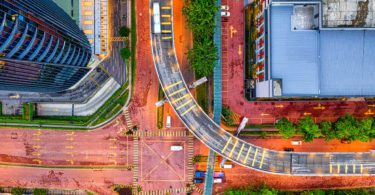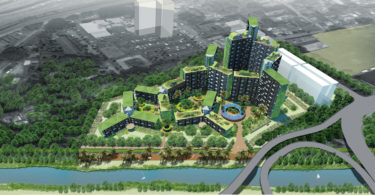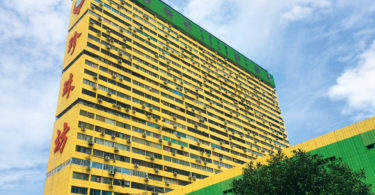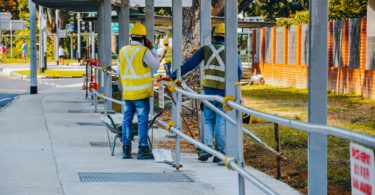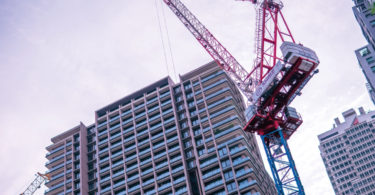At the crossroads of globalisation and urbanisation, how can we continue to evoke identity through allusions in modern design and construction?
In his seminal book “Leaves of the Same Tree: Trade and Ethnicity in the Straits of Melaka”, Professor Leonard Andaya paints a picture that reaches out in time, beyond the confines of the present geographical boundaries of nations. The memory of lands bordering the Straits of Melaka—known as lands within the Sea of ‘Malayu’—were rich and ‘rhizomic’ in expression, filled with multicultural crisscrossing of forces.
For centuries, this Southeast Asian region was a dynamically-charged field in which traders from China, India and the Middle East met and exchanged goods, services and cultural ideas.
Each ethnicity, race and group had their role and place, yet they were able to sustain their own identity amid a system of mutual benefits. Then, art and architecture co-existed, collided and criss-crossed with one another in varied syncretic forms of expression. Syncretism refers to two different cultures, beliefs and sets of principles and forms fusing and grafting onto each other, breeding new visions, patterns and forms, including its own identity.
At the epicentre of the region, Malaysia and its settlements, populations and urban centres have historically been a cultural quagmire of influences, with its own forms of tensions and hybridity. In the early 1900s, for example, local timber masonry designs appear to offshoot from each other into different forms, yet they support and sustain one another as they grow from the same ‘root’.
A city, with its forms and language, should forge its own pathway and find its own identity by enculturating from its own ancient past.

Water, steps, columns and trees are some of the kampung elements that can be used to create interstitial spaces in the city
IDENTITY CROSSROADS
As Asia as a region urbanises, we arrive at a crossroads in which global forces threaten our rich and distinctive identities. The speed of modernisation and urbanisation seems to outpace the region’s socio-cultural frameworks of thoughts and ideas and the evolution of social ideas and local movements.
In terms of architectural landscape, such trends are ever more evident. Our cities are increasingly shaped by global trends and forces, instead of local values. We no longer see architecture and the applied arts as a form of resistance. We become prone to homogeneity as a result of globalisation.
We surrender to external forces that overwhelm any internal resistance, including identity-making. If cities in this region are not seen to enculturate— to learn the traditional content of a culture and assimilate its practices and values—how then do we move forward? A city, with its forms and language, should forge its own pathway and find its own identity by enculturating from its own ancient past.
A return to sense and sustainability, through critical interpretation and infusion of cultural forms and vocabulary—the Malay vernacular, which arise from our local context—is crucial to create alternatives to faceless cubes and shoebox-like buildings.
The mute flushed façade that veers towards the sleek silent box can be embraced, yet there must be an enculturation through evoking references to a region that is rich in traditions, details and expressions of culture. The local is synonymous with the Green—both movements are rooted in the same soil, in which sustainability means a return to the ethics and values of the past, and should be more than speckles of greenery or elements that appear as afterthoughts.
Culture is a key driver of urban growth, enabling cities to compete yet forge increasingly global connections. Culture allows the region to distinguish cities and generate distinctive place identities amid a globalising world.

A contemporary youth cultural centre with imageries of past traditions of Kelantan
RESILIENCE OF TRADITION
To propose the idea of rootedness in Asia, the growth of a style must begin with its roots in order not to end up merely cosmetically transmuting or regurgitating the West. It must go deep, unearthing timeless and enduring principles and recalling more generic archetypes from the deep layers of history and a wide range of cultural forms.
Form and architectural language in Southeast Asian tropical antiquities, although linked to its humble ‘vernacular’ origins and timber-based traditions, are far from simple or simplistic. They recall richness in language and resonate principles that resemble the classic Renaissance architecture marvels of Europe, yet with their own proportions and character in the variations of post, beam and lintel structures and decorative ornamentations.
Though traditionally linked to artisanal traditions of timber and bamboo, these type-forms can be transposed into modern assembly of building systems. Timber traditions of the Malay world, example, are not only simple forms arising from cross beams supported by posts and secured by wedges, but they contain ‘a grammar’ that can elevate a modern structural and constructional framework.
Yet, rather than copying blindly, or nostalgically evoking the past, without reference to the city, we can focus on some of the perennial principles of the local vernacular that can be recalled and transposed in modern form, such as the following:
•an emphasis on a protective roof and roofline;
•the use of interstitial spaces, shaded extensions and projections;
•the presence of columnar spaces, rather than column-free spaces;
•a level of ‘complex’ motifs and decorative devices;
•an emphasis on ‘infusing climate’, rather than sealing from it; and
•façade expression through motifs and flora and fauna-based patterns.
The Asian path is one that is strewn with the above. Such a return to tradition can take on a faithful transformation, in which the infusion of such motifs, insertions and inflections are carried through modern adaptation and transmutation. We discuss some of these principles in greater detail here.
Evoking an identity is also about instilling soul in architecture and the applied arts via subtle yet detailed ornamentation.
Infusing Climate
Identity can be rhetorically, yet ecologically, expressed. Designing culturally means going beyond specifying a certain glass type towards a more profiled approach—embracing climate not only thermally, but expressively, in terms of the configured form and envelope, fine-tuned towards layering and shade.
Strong pitched roof forms are a feature of this region, yet these must be seen in their layering, rather than merely surmounting concrete blocks with roof forms. The roof should extend shade well beyond the wall-line, as shading the mass of concrete structures helps reduce heat absorption and night-time heat release.
The Malay house is also known to be wellventilated, with heightened doors and windows, as well as adequate space for air to flow through the roof and beneath the house. Among the most recognisable and defining elements of the Malay house are common spaces such as the anjung (porch) and serambi (veranda). When electricity was non-existent, the anjung and serambi evolved as a result of indigenous knowledge and local ingenuity.
These passive climatic features were naturally articulated for optimum comfort without consuming energy. These transitional zones also allow a person entering it to adapt his/her thermal comfort expectations, from the hot outdoors to the cool indoors, and vice versa.
Many have attempted to express ‘climate’ in city forms, such as incising or ‘punching’ an otherwise monolithic form with sky courts and deep balconies to recall the timeless character of the veranda. More explorations are needed to infuse tradition, its nuances and traits into bioclimatic forms, including elevated structures that can ‘free’ the ground floor, increase permeability and air change in the increasingly dense urban city, while at the same time, encouraging and facilitating the habits of walking under such shaded enclaves.
In spatial and urban terms, the ideas of Mustafa Kamal Bashar, a Master of Science candidate at the International Islamic University Malaysia (IIUM), combine water, steps, columns and trees—essential elements of the Malay kampung—to create interstitial spaces in the city.
The result goes beyond the ‘introverted’ airconditioned sealed façade to an ‘extroverted’ play of tectonics that subscribes to the environmental agenda, creating an alternative to the Modernist glass-and-steel-curtain-wall that characterises many modern tropical cities.
Applying Arts
Evoking an identity is also about instilling soul in architecture and the applied arts via subtle yet detailed ornamentation. Artisanship is a hallmark of traditional Asia, especially in the Malay world.
Malay carvings, as seen in wooden panels and walls, typically depict universal and transcendent patterns of nature—leaves, flowers, shoots and creepers. The spirituality of the culture is embodied and celebrated in its delicate and sinuous patterns, found in inscriptions, carvings, on texts, pottery, utensils and structures.
Abstracted patterns through ornamental elements can be adapted to modern high-tech settings, expressed not only as roof shapes, but also in façade systems, interior decorative panels, ventilation panels, sun-shading devices, brackets and balustrades.
A rich vocabulary of louvres and lattices, of gables and balustrades, is part of our identity and separates us from the rest of the world. Yet, it also emphasises the co-existence of modernity, tradition and history. The hovering pitch of roof planes, the formal elements and the projecting details appear to criss-cross each other into a play of poetics and contrasts. This recalls a sense of rootedness and evokes a sense of place making.

C2S Nusajaya: A reinterpretation of traditional Malay forms into a modern complex
MODERN REINTERPRETATIONS
One example of the modern reinterpretations of cultural identity is found in the final year interior design project of Maisarah Shaari, then an IIUM Bachelor of Applied Arts and Design (Interior Design) student. She took up the challenge of realising traditional character in an urban context with modern materials and treatments.
The brief was for a contemporary youth cultural centre with facilities and activity spaces, and the outcome is enculturated without copying culture, traditionalised without retreating into tradition. The interior scheme recalls the timeless principles of balance but inserts delicate patterns and imageries of past traditions, specifically with memories of the arts and culture of Kelantan and the local people.
Before the arrival of Islam, the east coast of peninsula Malaysia had already been a port call for traders from India and the Far East, with influences from other civilisations. With the arrival of Islam, motifs such as Kala, Makara, Garuda, Gunungan, Naga and Stupa were altered in accordance with the Islamic philosophy and faith. For example, the Kala and Makara were transformed into floral elements. The motivation and concept of the design for the youth cultural centre were to identify the cultural elements of the region and to innovate them with a contemporary approach, while still preserving the original identity.
At the other end of the spectrum, yet representing the same ‘tradition-modern’ dilemma is the C2S, a low-rise office complex commissioned by the Johor state government. Rather than drawing its design inspirations from the Middle East and Arab-Islamic eclecticism, the C2S forged a reinterpretation of traditional Malay forms into a modern complex. HL Reka Sdn Bhd was asked to create a complex steeped in the traditions of Johor and its ancestral influences from Riau, Jambi, Javanese and Bugis. Led by Huzir Hj Lip, the team studied variants of spaces in Malay palaces, with their steep, pitched roof planes and low-lying eaves, to learn from the layering of spaces and profiles.
The roof elements actually represent a layered form in which the cantilever reaches almost down to the earth, providing sufficient shade. The common pelantar (platform)—which acts as a divider between the front and back areas of a Malay house and often serves as a secondary entrance—was adopted and modified into a space that can be used for present-day functions, such as cafés or gyms. The allusion to the serambi, often connected to the core area with a slight drop in elevation in the style of an elephant nursing its calf (gajah menyusu), is intended to express the Malay values preserved in a modern space, where each vantage point provides views at different elevations.
Identity can be expressed through a tectonic theme, in which connectors and cross beams are dramatised with Malay beams and columns that connect like ‘joints without nails’. Spatially, an atrium is convened as a common space. In C2S Nusajaya, a multilevel gathering and viewing gallery was used to express a spatial and formal hierarchy of patterns, while subtly interweaving elemental references to Malay traditional forms and motifs.
The traditional floral motif (bunga banji) is transferred onto panels of etched glass in the atrium balustrades and repeated across all panels, while the pagar musang, a decorative grill commonly used on windows in traditional houses of Terengganu and Kelantan, is used in the complex.

The pagar musang decorative grills are common in traditional Terengganu and Kelantan homes
THE RESISTANCE OF DESIGN
Criticality in regionalism, as defined by historian Professor Kenneth Frampton, is described as ‘a design position of ‘resistance”. Resisting means defying the more expedient and seductive position of giving in to the normative form, a position of consumption and expediency. Often, this takes on the position of subtly, or starkly, opposing the ‘cult of the orthogonal and the straight line’.
As we traverse into the 21st-century world of connectivity, we increasingly become unaware that our consciousness and preconceptions are being bombarded from every direction, particularly by the latest fads. This information bombardment does not just inhibit our ability to think deeply and broadly, but also narrows our bandwidth too, resulting in tunnel vision. Therefore, the Internet-savvy Pinterestinspired architect or designer breed of today’s world sometimes end up with an outer shell form, space or envelope defaulted to the simplest design.
Malay allusions in architecture present one form of resistance. The Asian traditions hold many more such resistive pathways.
 DR SHIREEN JAHN KASSIM
DR SHIREEN JAHN KASSIM
Associate Professor Applied Arts and Design International Islamic University Malaysia (IIUM)
Dr Puteri Shireen is both an academician and a practicing specialist. She completed her doctorate in architecture at the University of Brighton. At IIUM’s Faculty of Architecture and Environmental Design, she teaches and supervises PhD and Masters students on building technology, sustainable building and energy-conscious design.
An authority on computational simulations and Green building standards, she has led companies and agencies to achieve their sustainability and low carbon emission targets. She is currently the lead supervisor in coordinating the steering committees on the Malaysian government’s Construction Industry Development Board (CIDB) and Public Works Department (JKR) to develop and launch an integrated carbon-based sustainable building rating assessment system for Malaysia.
She sits on the editorial and peer review board of Elsevier’s International Journal of the Sustainable Built Environment and is on the Scientific Committee for the International CONVR Conferences. She is currently the head of Architecture and Environmental Subcluster of the Transciplinary Research Group on Sustainable Cities.
Together with Norwina Mohd Nawawi and Noor Hanita Abdul Majid, she recently co-authored a book titled “The Resilience of Tradition: Malay Allusions in Contemporary Architecture”.

 Hong Kong
Hong Kong Singapore
Singapore Indonesia
Indonesia Tiếng Việt
Tiếng Việt ประเทศไทย
ประเทศไทย



